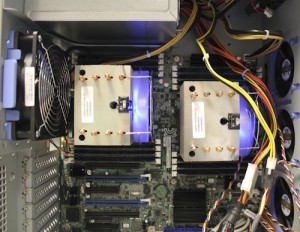TEST SETUP AND METHODOLOGY
 In testing the Super Talent RAIDDrive II Plus, along with all enterprise drives, we focus on long-term stability. In doing so, we stress products not only to their maximum rates, but also with workloads suited to enterprise environments.
In testing the Super Talent RAIDDrive II Plus, along with all enterprise drives, we focus on long-term stability. In doing so, we stress products not only to their maximum rates, but also with workloads suited to enterprise environments.
We use many off-the-shelf tests to determine performance, but we also have specialized tests to explore specific behaviors we encounter. With enterprise drives, you will see that we do not focus on many consumer level use-cases.
Our hope is that we present tangible results that provide relevant information to the buying public. Since the RAIDDrive II Plus has a RAID-on-Chip at its heart, there are countless configurations that we could have tested. We have focused on RAID 0 with default options so that we can compare it more closely with the competition.
LATENCY
To specifically measure latency, we use a series of 512b, 4K, and 8K measurements. At each block size, latency is measured for 100% read, 65% read/35% write, and 100% write/0% read mixes.
Looking at average latency is a good first step in determining the capabilities of a drive. Unfortunately for the RAIDDrive II Plus, this isn’t a good start. Latency across the board is high. These results are substantially higher than single SSDs.
Okay, these numbers are completely misleading. Since the RAIDDrive II Plus has 1GB of onboard cache, the round-trip latency is artificially high. Either way, this isn’t a good start.
ADVANCED WRITE TESTING
As we talked about in our Micron P400m SSD Review, SSDs have different performance states. Since the Super Talent RAIDDrive II Plus is an enterprise SSD, we will focus on steady state performance.
With the following tests, we stressed the drive using random 4KB write workloads across the entire span for at least 24 hours. This is more than enough to achieve steady state. The following graph is showing the latency and IOPS across an 11 hour span.
These results align with the previous latency tests. Overall, this isn’t a strong performance. In fact, even entry-level, read-focused SSDs, such as the Intel S3500, perform almost twice as fast.
Looking at the last hour’s worth of data points doesn’t make the results any better. In fact, we see some pretty large outliers. If you look at the specifications on the datasheet, Super Talent states that the RAIDDrive II Plus should be hitting closer to 65K IOPS. If we look at the latency over the first hour, when it is still in its fresh-out-of-box stage, and before it transitions into steady-state, we do get IOPS closer to 60K.
The problem is that for many enterprise applications, you cannot rely on FOB IOPS, you can only count on steady-state IOPS. For the RAIDDrive II Plus, these results will be a showstopper for many customers.
 The SSD Review The Worlds Dedicated SSD Education and Review Resource |
The SSD Review The Worlds Dedicated SSD Education and Review Resource | 

Any warranty mentioned? My big concern is the heavy use of those mini daughter card connectors. They tend to be susceptible to thermal expansion/contraction which can cause failures/corruptions. Also, I couldn’t see any supercaps on this unit.
I don’t have warranty information, my apologies. I almost included information about the USB connectors lifespan because of possible fretting, but decided to leave it out because the boards are incredibly secure. In higher shock and vibration environments (greater than a server rack), it could be a concern.
It’s not the USB connectors I worried about but those tiny daughterboard connectors.I didn’t see any screws holding the memory/controller card pairs together.